Differential Effects of the COVID-19 Lockdown and Regional Fire on the Air Quality of Medellín, Colombia
Abstract
:1. Introduction
2. Materials and Methods
2.1. Surface Stations
2.2. Traffic Data
2.3. Fire Activity
2.4. Effects of Lockdown on Pollutant Levels
2.5. Transport of Biomass Burning Emissions
3. Results
3.1. Lockdown and Fire Periods
3.2. Meteorological Conditions and Fire Activity
3.3. Changes in Pollutant Concentrations
3.4. Attribution of Fire Effects on Pollutant Levels
4. Discussion
5. Conclusions
Supplementary Materials
Author Contributions
Funding
Institutional Review Board Statement
Informed Consent Statement
Data Availability Statement
Acknowledgments
Conflicts of Interest
References
- Forouzanfar, M.H.; Afshin, A.; Alexander, L.T.; Anderson, H.R.; Bhutta, Z.A.; Biryukov, S.; Brauer, M.; Burnett, R.; Cercy, K.; Charlson, F.J.; et al. Global, Regional, and National Comparative Risk Assessment of 79 Behavioural, Environmental and Occupational, and Metabolic Risks or Clusters of Risks, 1990–2015: A Systematic Analysis for the Global Burden of Disease Study 2015. Lancet 2016, 388, 1659–1724. [Google Scholar] [CrossRef] [Green Version]
- Lelieveld, J.; Pozzer, A.; Pöschl, U.; Fnais, M.; Haines, A.; Münzel, T. Loss of Life Expectancy from Air Pollution Compared to Other Risk Factors: A Worldwide Perspective. Cardiovasc. Res. 2020, 116, 1910–1917. [Google Scholar] [CrossRef] [PubMed]
- Chowdhury, S.; Pozzer, A.; Dey, S.; Klingmueller, K.; Lelieveld, J. Changing Risk Factors That Contribute to Premature Mortality from Ambient Air Pollution between 2000 and 2015. Environ. Res. Lett. 2020, 15, 074010. [Google Scholar] [CrossRef]
- Gerten, C.; Fina, S.; Rusche, K. The Sprawling Planet: Simplifying the Measurement of Global Urbanization Trends. Front. Environ. Sci. 2019, 7, 140. [Google Scholar] [CrossRef]
- Crippa, M.; Guizzardi, D.; Muntean, M.; Schaaf, E.; Dentener, F.; van Aardenne, J.A.; Monni, S.; Doering, U.; Olivier, J.G.J.; Pagliari, V.; et al. Gridded Emissions of Air Pollutants for the Period 1970–2012 within EDGAR v4.3.2. Earth Syst. Sci. Data 2018, 10, 1987–2013. [Google Scholar] [CrossRef] [Green Version]
- Herrera-Mejía, L.; Hoyos, C.D. Characterization of the Atmospheric Boundary Layer in a Narrow Tropical Valley Using Remote-Sensing and Radiosonde Observations and the WRF Model: The Aburrá Valley Case-Study. Q. J. R. Meteorol. Soc. 2019, 145, 2641–2665. [Google Scholar] [CrossRef]
- Roldán-Henao, N.; Hoyos, C.D.; Herrera-Mejía, L.; Isaza, A. An Investigation of the Precipitation Net Effect on the Particulate Matter Concentration in a Narrow Valley: Role of Lower-Troposphere Stability. J. Appl. Meteorol. Climatol. 2020, 59, 401–426. [Google Scholar] [CrossRef]
- Henao, J.J.; Mejía, J.F.; Rendón, A.M.; Salazar, J.F. Sub-Kilometer Dispersion Simulation of a CO Tracer for an Inter-Andean Urban Valley. Atmos. Pollut. Res. 2020, 11, 928–945. [Google Scholar] [CrossRef]
- Mendez-Espinosa, J.F.; Belalcazar, L.C.; Morales Betancourt, R. Regional Air Quality Impact of Northern South America Biomass Burning Emissions. Atmos. Environ. 2019, 203, 131–140. [Google Scholar] [CrossRef]
- Ballesteros-González, K.; Sullivan, A.P.; Morales-Betancourt, R. Estimating the Air Quality and Health Impacts of Biomass Burning in Northern South America Using a Chemical Transport Model. Sci. Total Environ. 2020, 739, 139755. [Google Scholar] [CrossRef]
- Gkatzelis, G.I.; Gilman, J.B.; Brown, S.S.; Eskes, H.; Gomes, A.R.; Lange, A.C.; McDonald, B.C.; Peischl, J.; Petzold, A.; Thompson, C.R.; et al. The Global Impacts of COVID-19 Lockdowns on Urban Air Pollution: A Critical Review and Recommendations. Elem. Sci. Anthr. 2021, 9. [Google Scholar] [CrossRef]
- Venter, Z.S.; Aunan, K.; Chowdhury, S.; Lelieveld, J. COVID-19 Lockdowns Cause Global Air Pollution Declines. Proc. Natl. Acad. Sci. USA 2020, 117, 18984–18990. [Google Scholar] [CrossRef] [PubMed]
- Chauhan, A.; Singh, R.P. Decline in PM2.5 Concentrations over Major Cities around the World Associated with COVID-19. Environ. Res. 2020, 187, 109634. [Google Scholar] [CrossRef]
- Kroll, J.H.; Heald, C.L.; Cappa, C.D.; Farmer, D.K.; Fry, J.L.; Murphy, J.G.; Steiner, A.L. The Complex Chemical Effects of COVID-19 Shutdowns on Air Quality. Nat. Chem. 2020, 12, 777–779. [Google Scholar] [CrossRef]
- Toro, A.R.; Catalán, F.; Urdanivia, F.R.; Rojas, J.P.; Manzano, C.A.; Seguel, R.; Gallardo, L.; Osses, M.; Pantoja, N.; Leiva-Guzman, M.A. Air Pollution and COVID-19 Lockdown in a Large South American City: Santiago Metropolitan Area, Chile. Urban Clim. 2021, 36, 100803. [Google Scholar] [CrossRef] [PubMed]
- Rojas, J.P.; Urdanivia, F.R.; Garay, R.A.; García, A.J.; Enciso, C.; Medina, E.A.; Toro, R.A.; Manzano, C.; Leiva-Guzmán, M.A. Effects of COVID-19 Pandemic Control Measures on Air Pollution in Lima Metropolitan Area, Peru in South America. Air Qual. Atmos. Health 2021, 14, 925–933. [Google Scholar] [CrossRef]
- Zalakeviciute, R.; Vasquez, R.; Bayas, D.; Buenano, A.; Mejia, D.; Zegarra, R.; Diaz, V.; Lamb, B. Drastic Improvements in Air Quality in Ecuador during the COVID-19 Outbreak. Aerosol Air Qual. Res. 2020, 20, 1783–1792. [Google Scholar] [CrossRef]
- Zambrano-Monserrate, M.A.; Ruano, M.A. Has Air Quality Improved in Ecuador during the COVID-19 Pandemic? A Parametric Analysis. Air Qual. Atmos. Health 2020, 13, 929–938. [Google Scholar] [CrossRef]
- Nakada, L.Y.K.; Urban, R.C. COVID-19 Pandemic: Impacts on the Air Quality during the Partial Lockdown in São Paulo State, Brazil. Sci. Total Environ. 2020, 730, 139087. [Google Scholar] [CrossRef]
- Mendez-Espinosa, J.F.; Rojas, N.Y.; Vargas, J.; Pachón, J.E.; Belalcazar, L.C.; Ramírez, O. Air Quality Variations in Northern South America during the COVID-19 Lockdown. Sci. Total Environ. 2020, 749, 141621. [Google Scholar] [CrossRef]
- Ye, X.; Arab, P.; Ahmadov, R.; James, E.; Grell, G.A.; Pierce, B.; Kumar, A.; Makar, P.; Chen, J.; Davignon, D.; et al. Evaluation and Intercomparison of Wildfire Smoke Forecasts from Multiple Modeling Systems for the 2019 Williams Flats Fire. Atmos. Chem. Phys. Discuss. 2021, 1–69. [Google Scholar] [CrossRef]
- Posada-Marín, J.A.; Rendón, A.M.; Salazar, J.F.; Mejía, J.F.; Villegas, J.C. WRF Downscaling Improves ERA-Interim Representation of Precipitation around a Tropical Andean Valley during El Niño: Implications for GCM-Scale Simulation of Precipitation over Complex Terrain. Clim. Dyn. 2019, 52, 3609–3629. [Google Scholar] [CrossRef]
- Lovrić, M.; Pavlović, K.; Vuković, M.; Grange, S.K.; Haberl, M.; Kern, R. Understanding the True Effects of the COVID-19 Lockdown on Air Pollution by Means of Machine Learning. Environ. Pollut. 2021, 274, 115900. [Google Scholar] [CrossRef]
- AMVA. Plan Integral De Gestion De La Calidad Del Aire Para El Area Metropolitana Del Valle de Aburra—PIGECA. Area Metropolitana Del Valle de Aburra—Clean Air Institute—Universidad Pontificia Bolivariana. 2017. Available online: https://www.metropol.gov.co/ambiental/calidad-del-aire/Documents/PIGECA/PIGECA-Aprobado-Dic-2017.pdf (accessed on 30 August 2021).
- Giglio, L.; Schroeder, W.; Justice, C.O. The Collection 6 MODIS Active Fire Detection Algorithm and Fire Products. Remote Sens. Environ. 2016, 178, 31–41. [Google Scholar] [CrossRef] [PubMed] [Green Version]
- Rincón-Riveros, J.M.; Rincón-Caro, M.A.; Sullivan, A.P.; Mendez-Espinosa, J.F.; Belalcazar, L.C.; Quirama Aguilar, M.; Morales Betancourt, R. Long-Term Brown Carbon and Smoke Tracer Observations in Bogotá, Colombia: Association with Medium-Range Transport of Biomass Burning Plumes. Atmos. Chem. Phys. 2020, 20, 7459–7472. [Google Scholar] [CrossRef]
- Schroeder, W.; Oliva, P.; Giglio, L.; Csiszar, I.A. The New VIIRS 375m Active Fire Detection Data Product: Algorithm Description and Initial Assessment. Remote Sens. Environ. 2014, 143, 85–96. [Google Scholar] [CrossRef]
- Fu, Y.; Li, R.; Wang, X.; Bergeron, Y.; Valeria, O.; Chavardès, R.D.; Wang, Y.; Hu, J. Fire Detection and Fire Radiative Power in Forests and Low-Biomass Lands in Northeast Asia: MODIS versus VIIRS Fire Products. Remote Sens. 2020, 12, 2870. [Google Scholar] [CrossRef]
- Tobías, A.; Carnerero, C.; Reche, C.; Massagué, J.; Via, M.; Minguillón, M.C.; Alastuey, A.; Querol, X. Changes in Air Quality during the Lockdown in Barcelona (Spain) One Month into the SARS-CoV-2 Epidemic. Sci. Total Environ. 2020, 726, 138540. [Google Scholar] [CrossRef]
- Wang, X.; Zhang, R. How Did Air Pollution Change during the COVID-19 Outbreak in China? Bull. Am. Meteorol. Soc. 2020, 101, E1645–E1652. [Google Scholar] [CrossRef]
- Breiman, L. Random Forests. Mach. Learn. 2001, 45, 5–32. [Google Scholar] [CrossRef] [Green Version]
- Wang, Y.; Wen, Y.; Wang, Y.; Zhang, S.; Zhang, K.M.; Zheng, H.; Xing, J.; Wu, Y.; Hao, J. Four-Month Changes in Air Quality during and after the COVID-19 Lockdown in Six Megacities in China. Environ. Sci. Technol. Lett. 2020, 7, 802–808. [Google Scholar] [CrossRef]
- Zheng, H.; Kong, S.; Chen, N.; Yan, Y.; Liu, D.; Zhu, B.; Xu, K.; Cao, W.; Ding, Q.; Lan, B.; et al. Significant Changes in the Chemical Compositions and Sources of PM2.5 in Wuhan since the City Lockdown as COVID-19. Sci. Total Environ. 2020, 739, 140000. [Google Scholar] [CrossRef]
- Grange, S.K.; Carslaw, D.C. Using Meteorological Normalisation to Detect Interventions in Air Quality Time Series. Sci. Total Environ. 2019, 653, 578–588. [Google Scholar] [CrossRef]
- Grange, S.K.; Carslaw, D.C.; Lewis, A.C.; Boleti, E.; Hueglin, C. Random Forest Meteorological Normalisation Models for Swiss PM10 Trend Analysis. Atmos. Chem. Phys. 2018, 18, 6223–6239. [Google Scholar] [CrossRef] [Green Version]
- Vu, T.V.; Shi, Z.; Cheng, J.; Zhang, Q.; He, K.; Wang, S.; Harrison, R.M. Assessing the Impact of Clean Air Action on Air Quality Trends in Beijing Using a Machine Learning Technique. Atmos. Chem. Phys. 2019, 19, 11303–11314. [Google Scholar] [CrossRef] [Green Version]
- Copernicus Climate Change Service (C3S) ERA5: Fifth Generation of ECMWF Atmospheric Reanalyses of the Global Climate. Available online: https://www.ecmwf.int/en/forecasts/dataset/ecmwf-reanalysis-v5 (accessed on 30 August 2021).
- Hersbach, H.; Bell, B.; Berrisford, P.; Hirahara, S.; Horányi, A.; Muñoz-Sabater, J.; Nicolas, J.; Peubey, C.; Radu, R.; Schepers, D.; et al. The ERA5 Global Reanalysis. Q. J. R. Meteorol. Soc. 2020, 146, 1999–2049. [Google Scholar] [CrossRef]
- Mejia, J.F.; Gillies, J.A.; Etyemezian, V.; Glick, R. A Very-High Resolution (20m) Measurement-Based Dust Emissions and Dispersion Modeling Approach for the Oceano Dunes, California. Atmos. Environ. 2019, 218, 116977. [Google Scholar] [CrossRef]
- Darmenov, A.S.; da Silva, A.M. The Quick Fire Emissions Dataset (QFED): Documentation of Versions 2.1, 2.2 and 2.4; NASA: Washington, DC, USA, 2015. [Google Scholar]
- Kaiser, J.W.; Heil, A.; Andreae, M.O.; Benedetti, A.; Chubarova, N.; Jones, L.; Morcrette, J.-J.; Razinger, M.; Schultz, M.G.; Suttie, M.; et al. Biomass Burning Emissions Estimated with a Global Fire Assimilation System Based on Observed Fire Radiative Power. Biogeosciences 2012, 9, 527–554. [Google Scholar] [CrossRef] [Green Version]
- Li, F.; Zhang, X.; Roy, D.P.; Kondragunta, S. Estimation of Biomass-Burning Emissions by Fusing the Fire Radiative Power Retrievals from Polar-Orbiting and Geostationary Satellites across the Conterminous United States. Atmos. Environ. 2019, 211, 274–287. [Google Scholar] [CrossRef]
- Paugam, R.; Wooster, M.; Freitas, S.; Val Martin, M. A Review of Approaches to Estimate Wildfire Plume Injection Height within Large-Scale Atmospheric Chemical Transport Models. Atmos. Chem. Phys. 2016, 16, 907–925. [Google Scholar] [CrossRef] [Green Version]
- Sofiev, M.; Ermakova, T.; Vankevich, R. Evaluation of the Smoke-Injection Height from Wild-Land Fires Using Remote-Sensing Data. Atmos. Chem. Phys. 2012, 12, 1995–2006. [Google Scholar] [CrossRef] [Green Version]
- Xie, X.; Wu, T.; Zhu, M.; Jiang, G.; Xu, Y.; Wang, X.; Pu, L. Comparison of Random Forest and Multiple Linear Regression Models for Estimation of Soil Extracellular Enzyme Activities in Agricultural Reclaimed Coastal Saline Land. Ecol. Indic. 2021, 120, 106925. [Google Scholar] [CrossRef]
- Yuchi, W.; Gombojav, E.; Boldbaatar, B.; Galsuren, J.; Enkhmaa, S.; Beejin, B.; Naidan, G.; Ochir, C.; Legtseg, B.; Byambaa, T.; et al. Evaluation of Random Forest Regression and Multiple Linear Regression for Predicting Indoor Fine Particulate Matter Concentrations in a Highly Polluted City. Environ. Pollut. 2019, 245, 746–753. [Google Scholar] [CrossRef]
- Hernandez, A.J.; Morales-Rincon, L.A.; Wu, D.; Mallia, D.; Lin, J.C.; Jimenez, R. Transboundary Transport of Biomass Burning Aerosols and Photochemical Pollution in the Orinoco River Basin. Atmos. Environ. 2019, 205, 1–8. [Google Scholar] [CrossRef]
- Rodríguez-Gómez, C.; Echeverry, G.; Jaramillo, A.; Ladino, L.A. The Negative Impact of Biomass Burning and the Orinoco Low-Level Jet on the Air Quality of the Orinoco River Basin. Available online: https://www.revistascca.unam.mx/atm/index.php/atm/article/view/52979 (accessed on 30 August 2021).
- Li, K.; Jacob, D.J.; Liao, H.; Shen, L.; Zhang, Q.; Bates, K.H. Anthropogenic Drivers of 2013–2017 Trends in Summer Surface Ozone in China. Proc. Natl. Acad. Sci. USA 2019, 116, 422–427. [Google Scholar] [CrossRef] [Green Version]
- Taha, H. Modeling Impacts of Increased Urban Vegetation on Ozone Air Quality in the South Coast Air Basin. Atmos. Environ. 1996, 30, 3423–3430. [Google Scholar] [CrossRef]
- Bergin, M.S.; West, J.J.; Keating, T.J.; Russell, A.G. Regional Atmospheric Pollution and Transboundary Air Quality Management. Annu. Rev. Environ. Resour. 2005, 30, 1–37. [Google Scholar] [CrossRef]
- Larsen, A.E.; Reich, B.J.; Ruminski, M.; Rappold, A.G. Impacts of Fire Smoke Plumes on Regional Air Quality, 2006–2013. J. Expo. Sci. Environ. Epidemiol. 2018, 28, 319–327. [Google Scholar] [CrossRef] [PubMed] [Green Version]
- Spichtinger, N.; Wenig, M.; James, P.; Wagner, T.; Platt, U.; Stohl, A. Satellite Detection of a Continental-Scale Plume of Nitrogen Oxides from Boreal Forest Fires. Geophys. Res. Lett. 2001, 28, 4579–4582. [Google Scholar] [CrossRef]
- Hodzic, A.; Madronich, S.; Bohn, B.; Massie, S.; Menut, L.; Wiedinmyer, C. Wildfire Particulate Matter in Europe during Summer 2003: Meso-Scale Modeling of Smoke Emissions, Transport and Radiative Effects. Atmos. Chem. Phys. 2007, 7, 4043–4064. [Google Scholar] [CrossRef] [Green Version]
- Pope, R.J.; Arnold, S.R.; Chipperfield, M.P.; Reddington, C.L.S.; Butt, E.W.; Keslake, T.D.; Feng, W.; Latter, B.G.; Kerridge, B.J.; Siddans, R.; et al. Substantial Increases in Eastern Amazon and Cerrado Biomass Burning-Sourced Tropospheric Ozone. Geophys. Res. Lett. 2020, 47, e2019GL084143. [Google Scholar] [CrossRef]
- Dreessen, J.; Sullivan, J.; Delgado, R. Observations and Impacts of Transported Canadian Wildfire Smoke on Ozone and Aerosol Air Quality in the Maryland Region on June 9–12, 2015. J. Air Waste Manag. Assoc. 2016, 66, 842–862. [Google Scholar] [CrossRef] [PubMed]
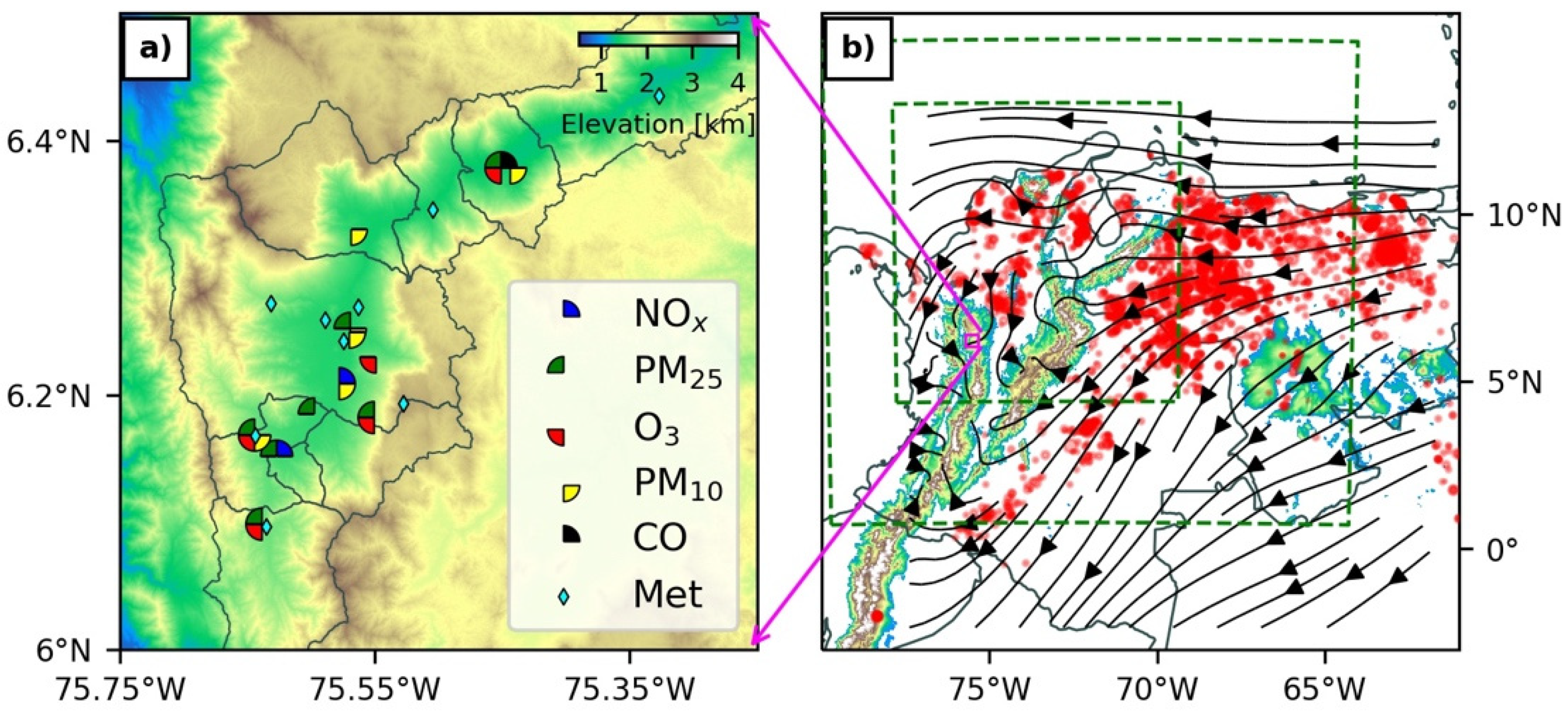
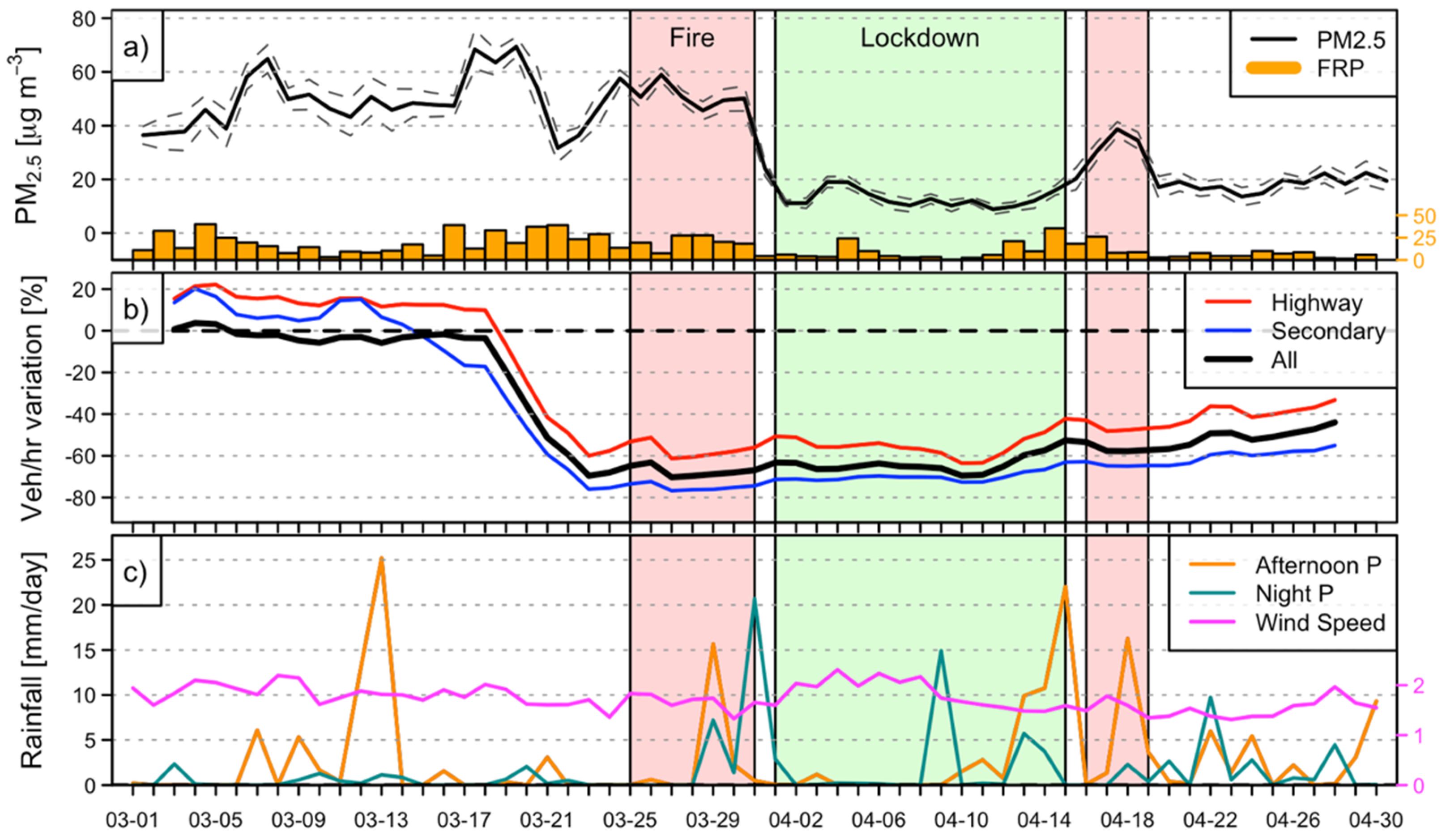

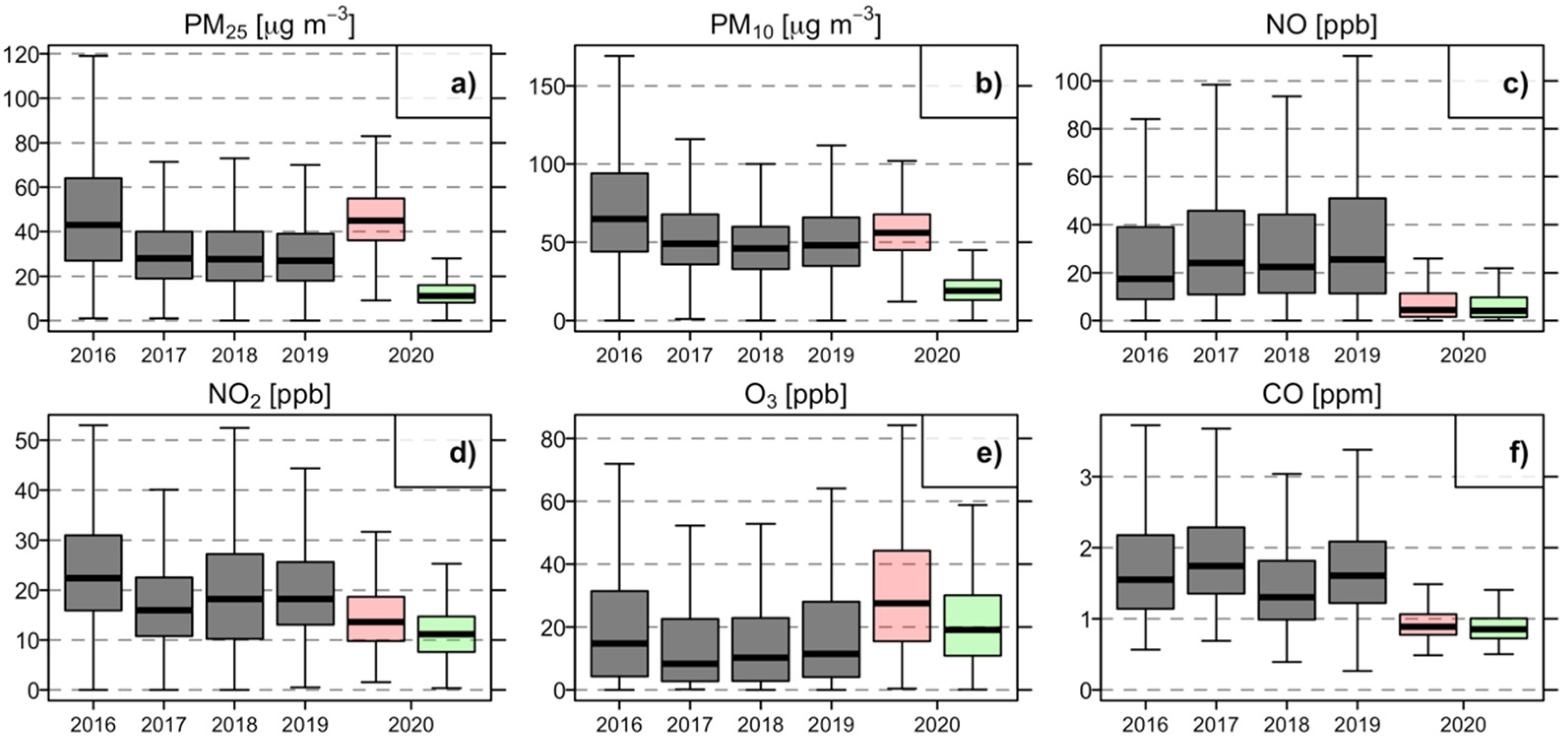

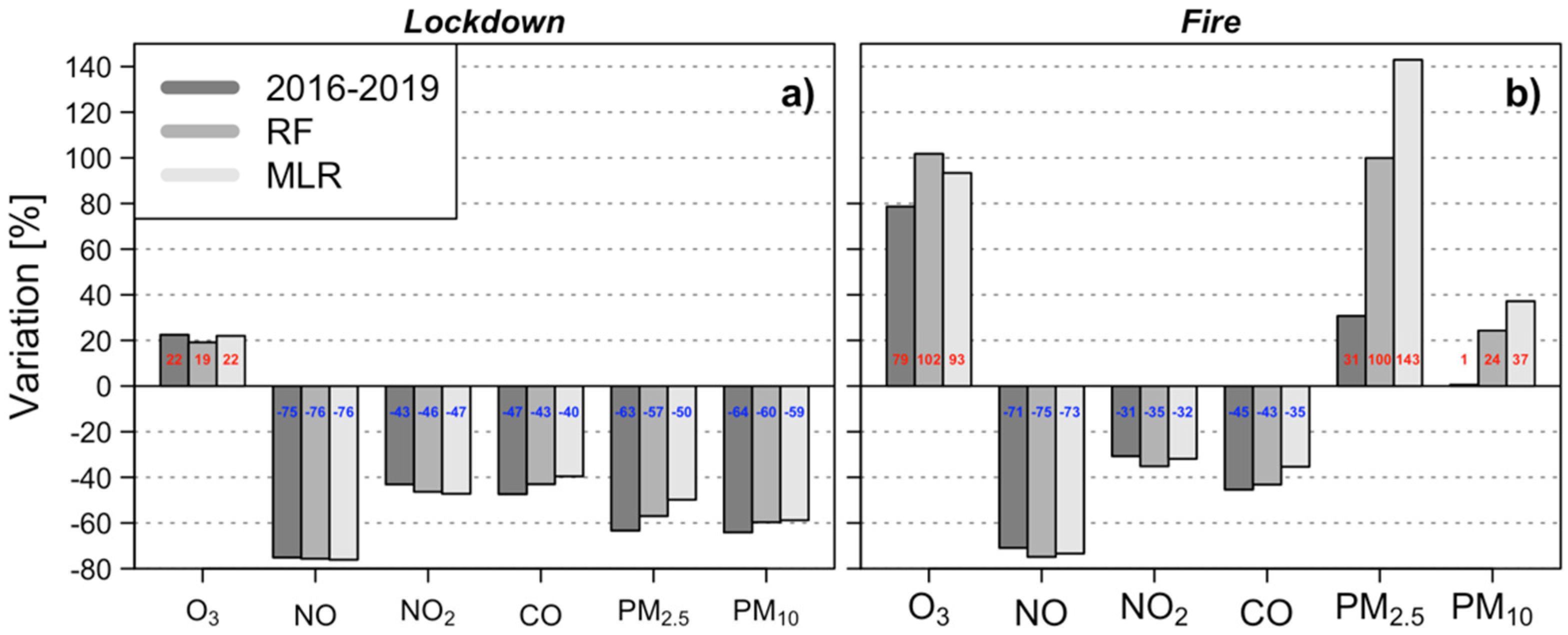

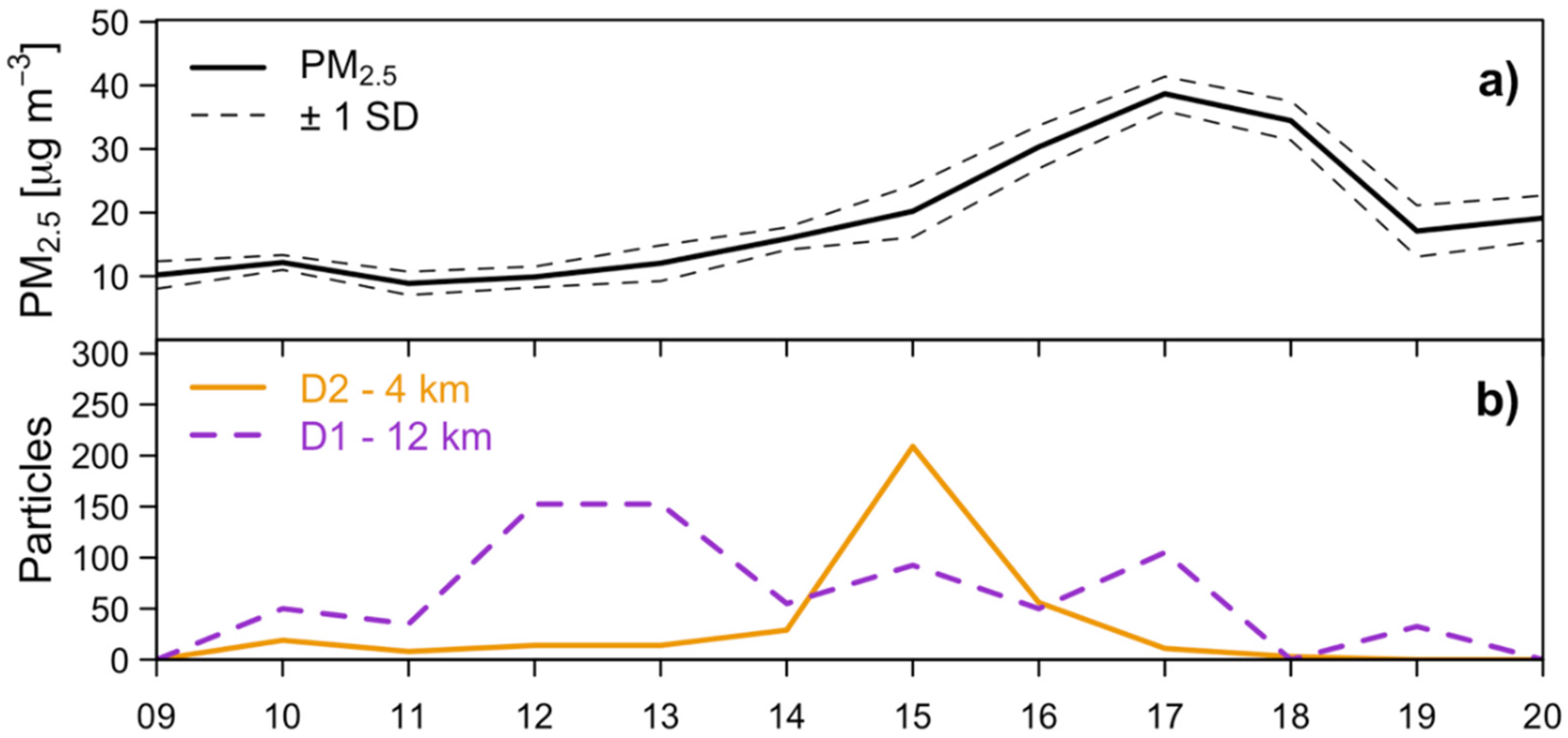
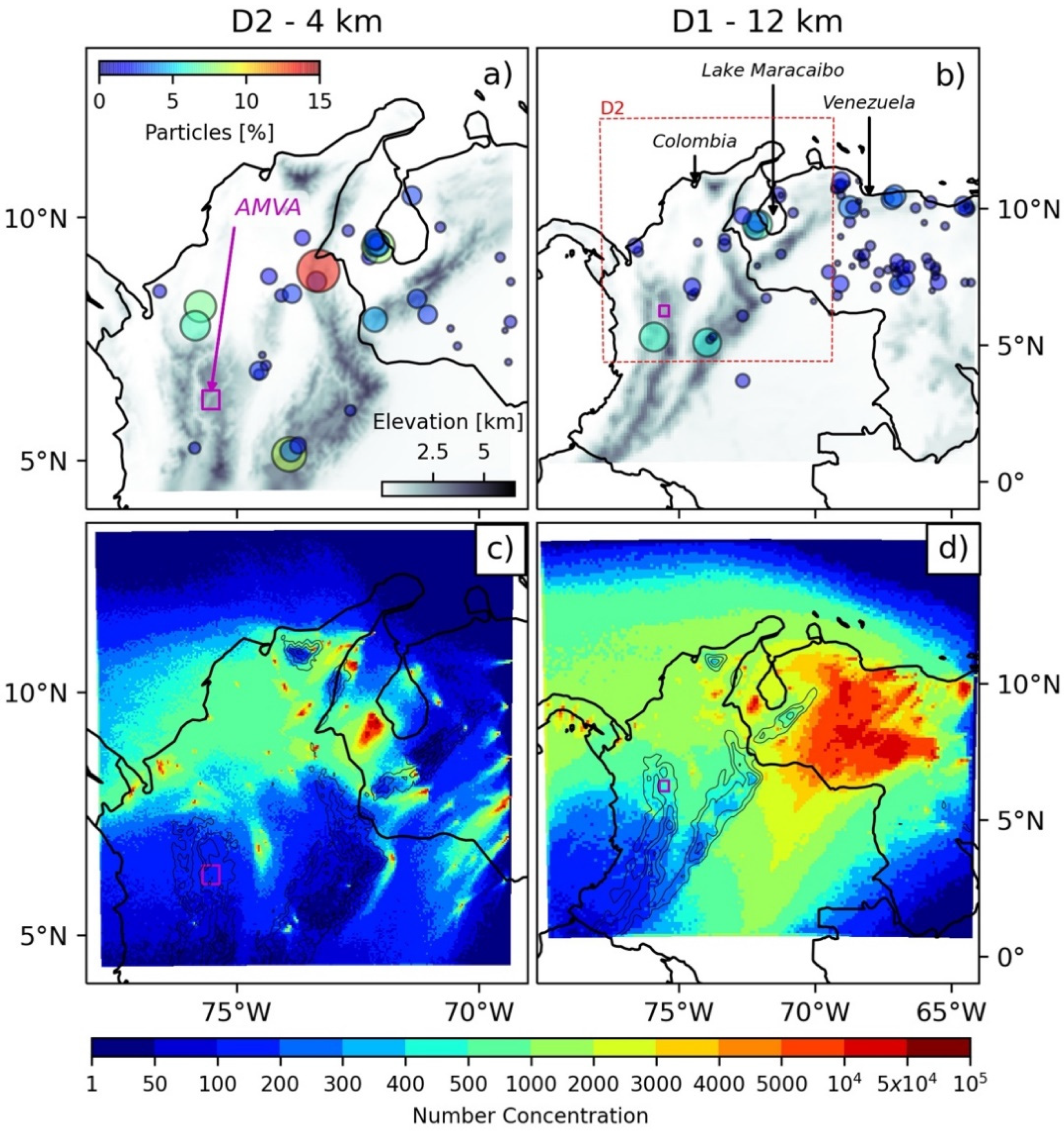
| Pollutant | RF | MLR |
|---|---|---|
| RMSE (R2) | RMSE (R2) | |
| O3 | 3.10 (0.65) | 3.67 (0.50) |
| PM10 | 8.49 (0.66) | 12.01 (0.41) |
| PM2.5 | 5.82 (0.65) | 8.18 (0.43) |
| CO | 0.27 (0.50) | 0.30 (0.58) |
| NO | 9.25 (0.54) | 10.80 (0.37) |
| NO2 | 3.65 (0.62) | 5.69 (0.15) |
| Pollutant | Lockdown | Fire | Ref | ||||
|---|---|---|---|---|---|---|---|
| Obs | RF | MLR | Obs | RF | MLR | 2016–2019 | |
| O3 (ppb) | 20.95 | 17.59 | 17.18 | 30.57 | 15.15 | 15.81 | 17.11 |
| PM10 (μg/m3) | 20.33 | 50.44 | 49.32 | 56.96 | 45.83 | 41.53 | 56.80 |
| PM2.5 (μg/m3) | 12.75 | 29.62 | 25.41 | 45.45 | 22.73 | 18.71 | 34.80 |
| CO (ppm) | 0.90 | 1.58 | 1.49 | 0.94 | 1.65 | 1.45 | 1.72 |
| NO (ppm) | 8.28 | 34.05 | 34.64 | 9.68 | 38.47 | 36.37 | 33.31 |
| NO2 (ppm) | 11.54 | 21.50 | 21.85 | 14.05 | 21.67 | 20.62 | 20.28 |
Publisher’s Note: MDPI stays neutral with regard to jurisdictional claims in published maps and institutional affiliations. |
© 2021 by the authors. Licensee MDPI, Basel, Switzerland. This article is an open access article distributed under the terms and conditions of the Creative Commons Attribution (CC BY) license (https://creativecommons.org/licenses/by/4.0/).
Share and Cite
Henao, J.J.; Rendón, A.M.; Hernández, K.S.; Giraldo-Ramirez, P.A.; Robledo, V.; Posada-Marín, J.A.; Bernal, N.; Salazar, J.F.; Mejía, J.F. Differential Effects of the COVID-19 Lockdown and Regional Fire on the Air Quality of Medellín, Colombia. Atmosphere 2021, 12, 1137. https://doi.org/10.3390/atmos12091137
Henao JJ, Rendón AM, Hernández KS, Giraldo-Ramirez PA, Robledo V, Posada-Marín JA, Bernal N, Salazar JF, Mejía JF. Differential Effects of the COVID-19 Lockdown and Regional Fire on the Air Quality of Medellín, Colombia. Atmosphere. 2021; 12(9):1137. https://doi.org/10.3390/atmos12091137
Chicago/Turabian StyleHenao, Juan J., Angela M. Rendón, K. Santiago Hernández, Paola A. Giraldo-Ramirez, Vanessa Robledo, Jose A. Posada-Marín, Natalia Bernal, Juan F. Salazar, and John F. Mejía. 2021. "Differential Effects of the COVID-19 Lockdown and Regional Fire on the Air Quality of Medellín, Colombia" Atmosphere 12, no. 9: 1137. https://doi.org/10.3390/atmos12091137







